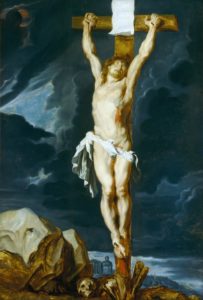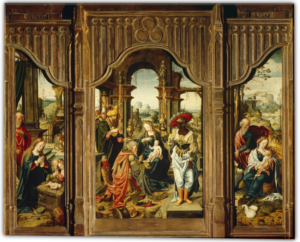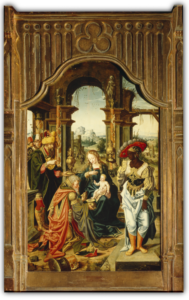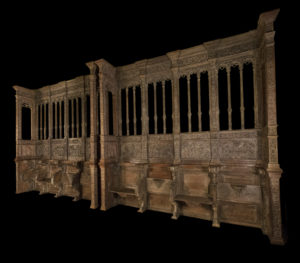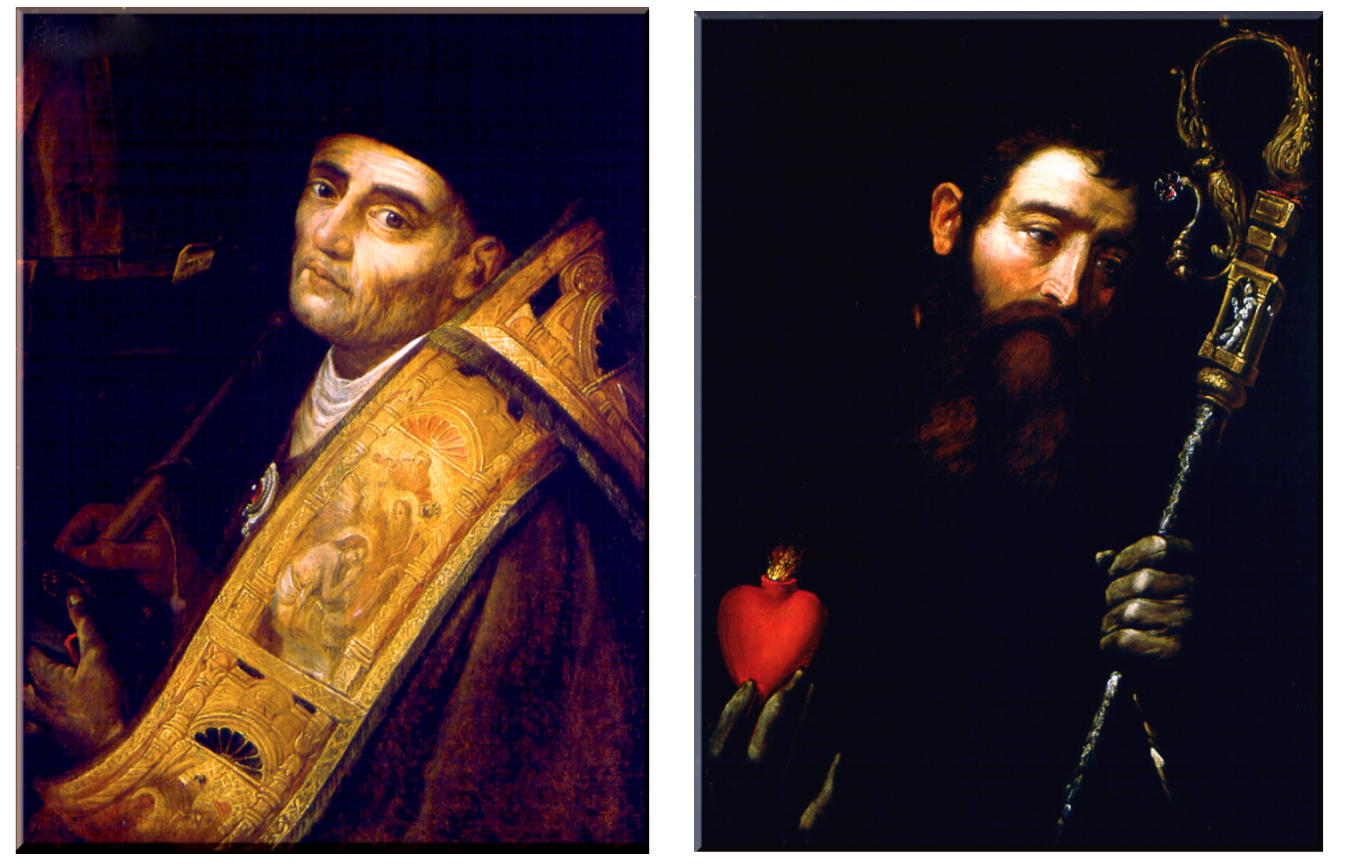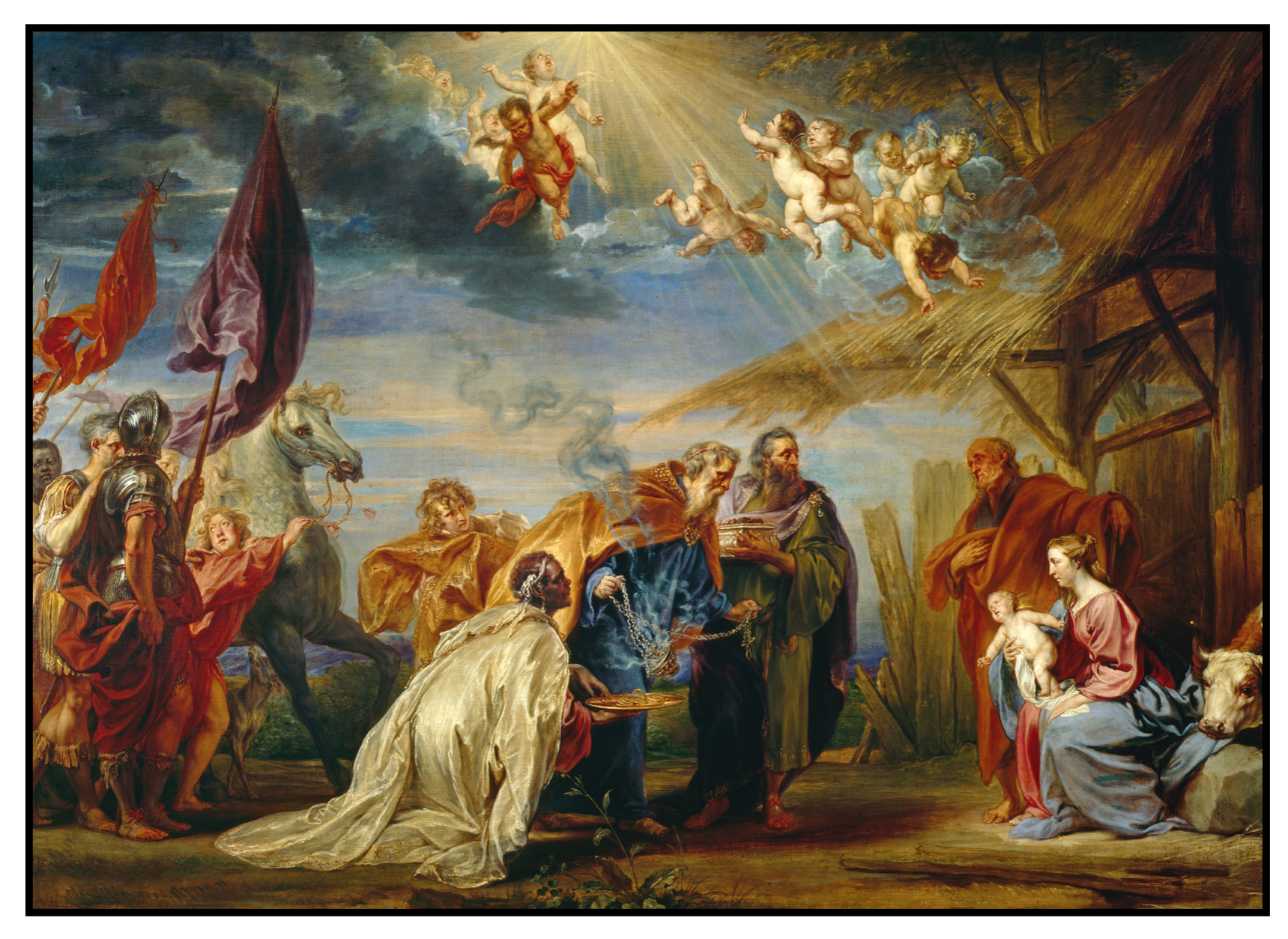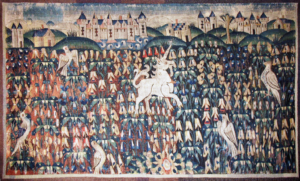Art historian Michael Jaffe notes that Rubens’s crucified Christ marks a watershed in Christian iconography. Watch the video to learn more.
Tag Archives: Flemish art
The historical and iconographic details in this early Spanish painting by Jaun de Flandes make it one of M&G’s most intriguing works.
In this triptych the artist beautifully pictures several of the most familiar Christmas story events.
Triptych: Nativity, Adoration of the Magi, Flight into Egypt
Oil on panel
Jan Swart van Groningen
As his name states, Jan Swart came from the town of Groningen in the Netherlands. No documents tell of his training, but this painting depicts his fondness for showing people in unusual headgear. It also reveals his other work as a book illustrator. Here Swart pictures the central truth of Christ’s coming into the world, placed within the context of His early life.
M&G’s Triptych (three panels) illustrates three events in Christ’s early life: the Nativity, Adoration of the Magi, and the Flight into Egypt. The birth of Christ signified the coming of a new covenant—a covenant that forever removed the necessary demand of the Old Testament Law requiring atonement for sin before the joy of reunification and fellowship with God.
Swart unifies the three stories of the triptych through a key motif: broken architectural elements. The left panel (clearly the stable with a curious cow in the background) has the Christ-child lying on a manger of ornate stone, possibly the base of a larger pillar. But the broken pillar at the base of the marble manger (right foreground) catches the viewer’s attention because its decoration is too fine to be part of a stable and because it matches all the other pillars, especially the broken one in the foreground of the Adoration. In the Flight, the Madonna and Child are resting on a pillar’s base by the side of the road. In each panel then, Swart uses the broken columns to point to Christ’s reason for coming to earth.
However, Swart develops his illustration of the Scriptures even more, specifically within the large, middle panel. The Adoration is central to an understanding of that New Covenant that Christ came to establish. To appreciate his storytelling, one must carefully consider the motif of the number 3.
Three in Composition
Swart adorns the frame of the middle panel with a trefoil centered over the Madonna and Child. This iconography tells the viewer that the scenes are the story of the One God in Three Persons, the Trinity of which Christ is the second Person. Swart then emphasizes this truth through more tripling in the work. There are three openings in the room, which is clearly not a stable. In doing so he follows the same Scriptural distinction that the Magi came to “the house where the young child was.” Interestingly, each opening emphasizes a key character in the story:
- The left doorway holds the third magus as well as some other apparently well-to-do men, based on their clothing.
- The middle opening, framing the Virgin’s head, shows some soldiers in the background. Their presence alludes to Herod’s men, who were tasked with murdering the male infants in Bethlehem to prevent Christ from becoming king—the reason the family fled to Egypt.
- The right opening frames a large building in the distance with townspeople going about their business, unaware or uncaring about the visit of such prestigious visitors to their village and to the Savior of the world. The full, frontal view of the first magus in his ostentatious dress already makes him a focal point, but the opening behind him seems to frame him as if he were posing for a portrait.
Three Gifts
Swart does not include Joseph in this panel, though Christ’s earthly father is often part of this family scene. The reason is that the focus is on the heavenly family of the Christ. The three gifts of the magi emphasize a different family than that of Joseph’s.
- Gold is a gift for a king and points to Christ’s position as the King of heaven who will be rejected and killed by His lawful subjects.
- Frankincense, a gift for deity, represents the fact that Christ is the God of heaven who will not only be the priest who offers the sacrifice for sin but will also be the sacrifice itself.
- Myrrh is a burial oil symbolizing the death that will be necessary to establish the New Covenant of grace. It also emphasizes the unbelievable story of the Christ: The King of heaven and the Creator of the world will die for those who owe Him everything and will allow them the exercise of their free wills to reject or accept Him.
Christ’s lineage through Joseph is that of the kings of Israel, perhaps another reason that he is not present: Christ’s royal claim to these kingly gifts relies on His eternal lineage, not that of His earthly father’s.
Three Magi
The three holders of the gifts are also interesting to note. Those held by the two Magi on the side are urn shape, commensurate with their gifts of oil. Logically then, the wide-mouthed lidded bowl offered by the central magus is the gold: the kneeling pose and the type of gift indicate the submissiveness of a subject to a king. Christ’s pose and gesture indicate His position as both king and priest in extending a blessing to His subjects.
Three Columns
The three ornate pillars within the middle panel are interesting as they are in differing conditions. The pillar in the foreground matches the one in the stable. But the other two frame the Christ and His mother. Perhaps Swart is showing the progressive nature of the New Covenant’s institution. One column is broken, another is empty, and the third fulfills its purpose. Christ must be born, die, and resurrect in order to complete the New Covenant. Swart again uses the number three to tell the story of Christ, even as an infant, has set in motion the redemption of the world.
Dr. Karen Rowe, M&G Board Member
Published in 2019
Choir Stalls
Oak
Jan Terwen Aertsz.
Flemish, 16th century
Churches and cathedrals throughout time have something architecturally in common: a location for the choir. Where the choir is placed differs in the various places of worship, yet the choir accentuates the central focus of the church: the altar. In many early European monasteries and later collegiate churches, the choir was positioned along the chancel which separates the nave (where the laity would sit) from the altar. The chancel is lined with rows of seating for the choir members. Every detail within Medieval and Renaissance places of worship were handcrafted, including the choir’s seating or choir stalls.
Choir stalls consist of carved, individual seats divided by armrests; these seats are attached to a long, carved dorsal panel (a short or high backrest board) and sometimes a canopy. M&G’s pair of sturdy oak Choir Stalls date to the 16th century and were designed by Gothic Flemish artist Jan Terwen Aertsz.
Little is known about Jan Terwen Aertzs. who lived a long life of 78 years. Born in 1511 and later educated at the Dordrecht School, Jan was considered a master woodcarver in Dort, also known as Dordrecht. While the exact church in the Netherlands from which M&G’s Choir Stalls originate remains a mystery, the location of Jan’s greatest work is on view in the Grote Kerk in Dordrecht. The church’s choir stalls, made between 1538-1542, demonstrate Jan’s skill and eye for detail, and are pristine examples of Flemish woodworking in the 16th century.
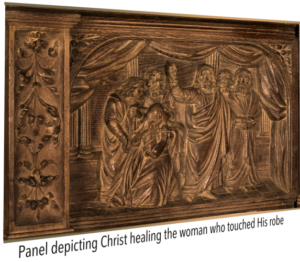 M&G’s Choir Stalls provide two sets of four seats each and are covered in finely detailed carvings. For example, the fins under the armrest are devised to look like eagles with every feather individually carved into the hard oak. The dorsal and end panels of the stalls contain images from various Biblical stories, including King Solomon displaying his God-given wisdom with the two mothers, and the believing woman healed by just a touch of Christ’s robe. Every minute design is accounted for—from the patterned hem of a character’s tunic, and the hair on Jesus’ head and beard, to the scenes’ distant mountains in the background, and the patterns in the tile underfoot. Surrounding these narratives are decorated spindles and more reliefs consisting of fruit and flowers flanked by winged, mythological creatures.
M&G’s Choir Stalls provide two sets of four seats each and are covered in finely detailed carvings. For example, the fins under the armrest are devised to look like eagles with every feather individually carved into the hard oak. The dorsal and end panels of the stalls contain images from various Biblical stories, including King Solomon displaying his God-given wisdom with the two mothers, and the believing woman healed by just a touch of Christ’s robe. Every minute design is accounted for—from the patterned hem of a character’s tunic, and the hair on Jesus’ head and beard, to the scenes’ distant mountains in the background, and the patterns in the tile underfoot. Surrounding these narratives are decorated spindles and more reliefs consisting of fruit and flowers flanked by winged, mythological creatures.
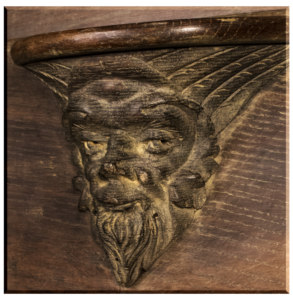 One of the most fascinating details of the Choir Stalls are the misericords. Misericords (from the Latin word for pity and heart, literally pity of the heart or compassion of the heart) are molded brackets on the underside of a seat. Choirs or monks would stand for hours singing and participating in the worship ceremony; to provide them with a modicum of comfort and stability, these misericords or “mercy seats” were added. When the choir members would stand to sing, they could lift the seat up and surreptitiously rest against this small structure while still appearing to be standing.
One of the most fascinating details of the Choir Stalls are the misericords. Misericords (from the Latin word for pity and heart, literally pity of the heart or compassion of the heart) are molded brackets on the underside of a seat. Choirs or monks would stand for hours singing and participating in the worship ceremony; to provide them with a modicum of comfort and stability, these misericords or “mercy seats” were added. When the choir members would stand to sing, they could lift the seat up and surreptitiously rest against this small structure while still appearing to be standing.
The ownership history, or provenance, of these beautiful seats is long, mysterious, and fascinating. The choir stalls survived the iconoclasm that followed the Protestant Reformation sweeping through the Netherlands as staunch Catholic Philip II of Spain fought to retain Flanders, where they remained undamaged until the early 20th century. As America entered the Gilded Age with its booming economy, many American business and factory owners became millionaires; they wished to display their newly-earned wealth and position by designing grand homes decorated in the Old-World style. Men like architect Stanford White were sent to Europe to purchase whole rooms of traditional Medieval or Renaissance décor and ship the furnishings back to America. White chose the Choir Stalls to adorn Hearst Castle built by William Randolph Hearst, the newspaper magnate. The choir stalls decorated Hearst’s home until his bankruptcy during the Great Depression. In 1941, Hammer Galleries acquired the choir stalls at auction. A later owner gifted the Choir Stalls to the Collection in 1968, where they found a home among objects and paintings of the same age. While they are not being used for their original purpose, the Choir Stalls allow M&G’s guests a glimpse into 16th-century cathedrals.
Ashley Ellis, M&G History Intern
Published in 2019
St. Ambrose and St. Augustine
Oil on panel
Gaspar de Crayer
Flemish, 1584–1669
Gaspar de Crayer spent much of his career as a painter for the elite of the Spanish Netherlands. In addition to numerous portraits, he completed a large number of altarpieces. Matthias Depoorter notes: “The motifs that he borrows from the work of Rubens are so specific that people suspect that he had contact with Rubens’s studio.” For example, the figurative influence, coloration, and brushwork of Rubens’s Entombment (figure 1) is also clearly evident in De Crayer’s Deposition (figure 2).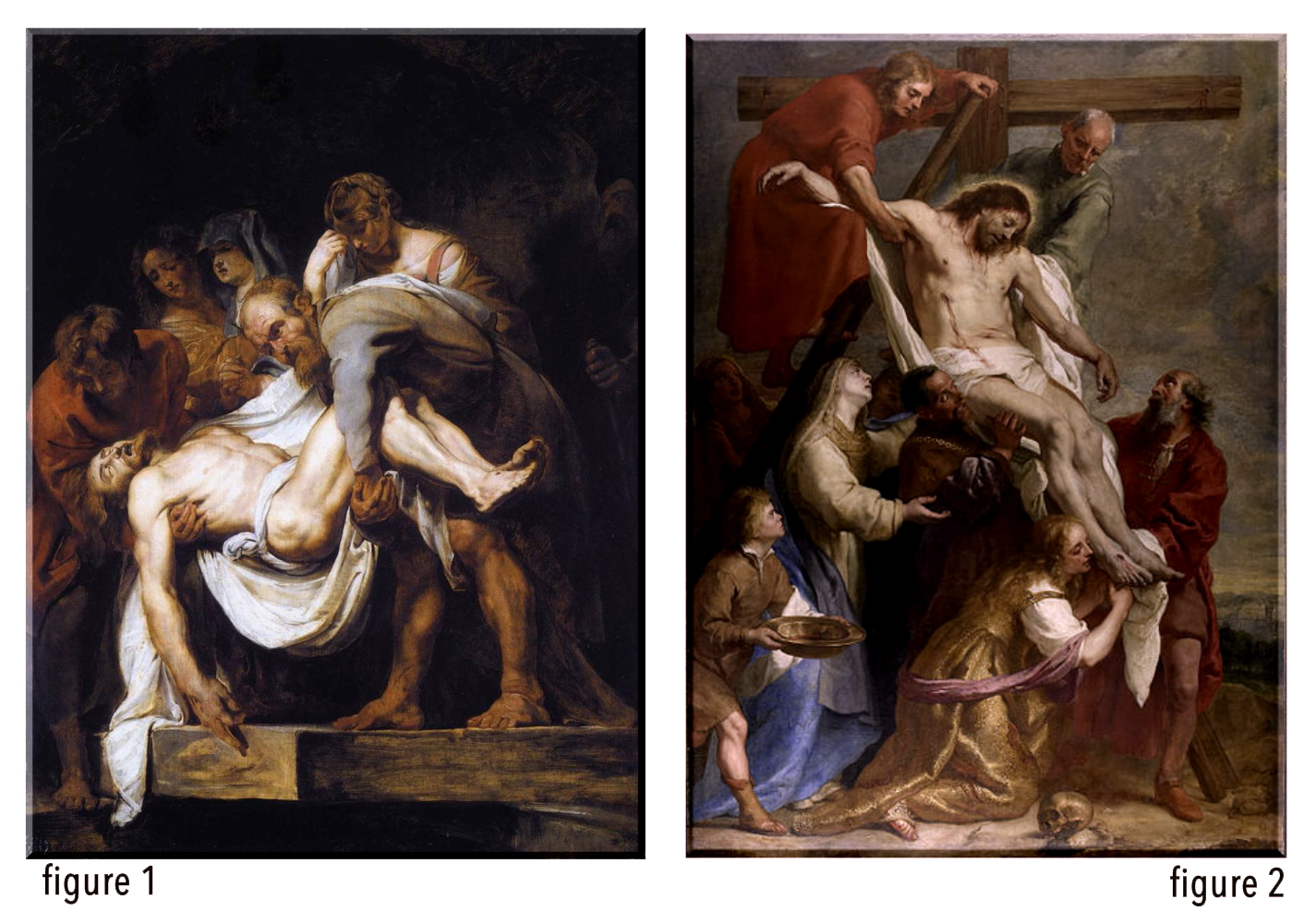
Depoorter goes on to point out that later in De Crayer’s career the influence of Anthony Van Dyck (Rubens most noted pupil) emerges. Critics observe that Van Dyck’s portraits are characterized by a “relaxed elegance.” But this elegance is enriched by a subtle emotional sentiment that intuitively connects the subject to the viewer. These qualities are readily discerned both in Van Dyck’s Self-Portrait (figure 3) and in De Crayer’s portraits of St. Ambrose and St. Augustine from M&G’s collection.
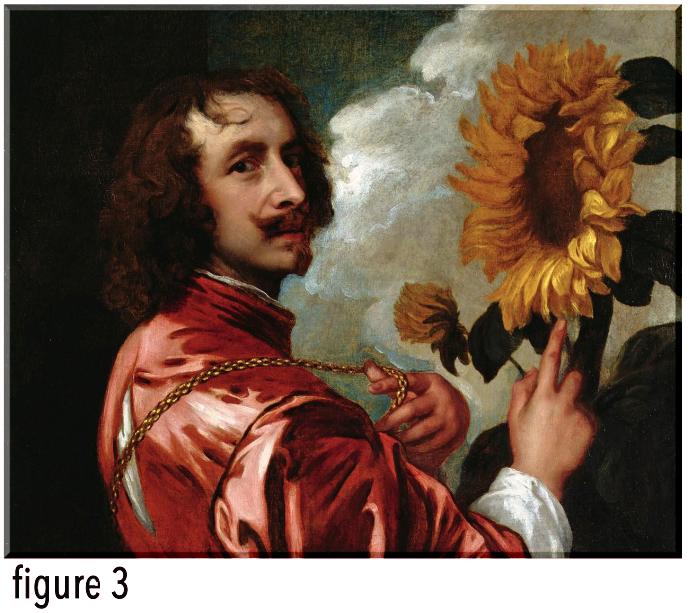 Ambrose was a revered Greek scholar, poet, lawyer, and orator. Trained in politics and law he was literally thrust into an ecclesiastical life. When Auxentius, Bishop of Milan, died in 374 the Arian heresy was on the rise. During the election for the new bishop a violent outbreak seemed inevitable until the 35-year-old Ambrose stood up in the public square and gave an impassioned speech “exhorting the people to proceed in their choice in the spirit of peace.” Following his plea, the whole assembly took up the cry “Ambrose for Bishop.” Although his election astonished him, he determined to take up the task with vigor. Aware of his theological limitations he embarked on an arduous study of Scripture. He also read extensively the writings of the church fathers, especially Origen and Basil. Before long he was revered by both low and high born as a “good shepherd.” The garments he wears in De Crayer’s portrait symbolize his ecclesiastical station.
Ambrose was a revered Greek scholar, poet, lawyer, and orator. Trained in politics and law he was literally thrust into an ecclesiastical life. When Auxentius, Bishop of Milan, died in 374 the Arian heresy was on the rise. During the election for the new bishop a violent outbreak seemed inevitable until the 35-year-old Ambrose stood up in the public square and gave an impassioned speech “exhorting the people to proceed in their choice in the spirit of peace.” Following his plea, the whole assembly took up the cry “Ambrose for Bishop.” Although his election astonished him, he determined to take up the task with vigor. Aware of his theological limitations he embarked on an arduous study of Scripture. He also read extensively the writings of the church fathers, especially Origen and Basil. Before long he was revered by both low and high born as a “good shepherd.” The garments he wears in De Crayer’s portrait symbolize his ecclesiastical station.
Although Ambrose is still counted as one of the great doctors of the Western church, his reputation is overshadowed by his most famous convert, Augustine of Hippo. It is not surprising, therefore, that Gaspar de Crayer would do a companion portrait of Augustine. This work, also part of the M&G collection, was featured as Object of the Month in February 2016.
Augustine acknowledged that Ambrose was the key figure in bringing him to Christ. He records in his Confessions that, “This man of God welcomed me, as a father. As a result, I began to love him, not because of his teaching, but because of his warm and loving personality. I enjoyed hearing him preach, not in order to learn from what he said, but in order to admire and learn to imitate his eloquence. Indeed, I still despised the doctrines he taught. Yet, by opening my heart to the sweetness of his speech, the truth of his teaching began to enter my soul, little by little.” Ambrose would baptize Augustine on Easter morning in 387. Soon after Augustine returned to North Africa where he eventually became Bishop of Hippo, ruling in that turbulent African diocese for 34 years until his death in 430.
Donnalynn Hess M&G Director of Education
Published in 2018
The Adoration of the Magi
Oil on canvas, Initialed and dated, lower right: JB 1652
Jan Boeckhorst, called Lange Jan
Flemish, c. 1604–1668
Click on the link for additional reference information.
Among the Museum & Gallery’s collection, there are both famous and unknown artists. But what about those who fall right in the middle? What about the artists who have active careers and equal skill to the “greats,” but never achieve the fame of their contemporaries? One of these artists is the Flemish master, Jan Boeckhorst.
Jan Boeckhorst, nicknamed Lange Jan (“Tall John”) was born in Münster, Germany in 1604. At seventeen, he became a canon in the Jesuit church, but at the advanced age of twenty-two (long past the standard age for training) decided to become a painter.
In the 1620s, he moved to the coastal city of Antwerp—home to some of the greatest artists of his time. Some historians claim he studied with Jacob Jordaens while others say it was Peter Paul Rubens. More than likely, Boeckhorst studied with Jordaens because Rubens was in Spain and England in the late 1620s. Around 1634, Boeckhorst achieved the title of Master in Antwerp’s Guild of St. Luke and worked alongside the other Flemish masters including Rubens and Anthony van Dyck. Boeckhorst visited Italy twice to study the sixteenth-century Venetian masters such as Titian and Tintoretto and returned to Antwerp by 1640.
Throughout his later life, he painted a variety of subject matter including religious and mythological for church altarpieces and private collectors. His artistic work ranged from paintings, designing tapestries, and illustrating for religious books. He also contributed to the founding of the Antwerp Academy. After a full life, he died on April 21, 1668.
Despite his active career, much of Boeckhorst’s work is unknown, unsigned or wrongly attributed, so it has been difficult to compile a comprehensive list of his art. One of the reasons his work might be misattributed is his close work relationship with Rubens. There are many evidences of their collaboration based on the standard studio practice of the time. Boeckhorst would help touch up paintings under Rubens’ instructions and even assisted the master in large commissions. After Rubens’ death in 1640, Boeckhorst finished or even restored Rubens’ remaining works. An example of their collaboration is King David Playing the Harp at the Städel Museum.
In M&G’s collection, there are three paintings by Boeckhorst; of these The Adoration of the Magi is considered his greatest work in America. In the lower right corner, his initials and date are painted on a rock face: JB 1652.
Boeckhorst displays a heightened attention to texture with the wafting incense, richness of the garments, and different animals. Because of his saturated colors, graceful composition and dramatic movement, scholars consider this painting to be a masterpiece of the High Baroque style.
KC Christmas, M&G graduate assistant
Published in 2017
Mille-Fleurs Tapestry
Franco-Flemish, c. 1480
Gift of Z.E. Marguerite Pick in memory of Misty
Click on the links throughout the article to view additional artists’ works and reference material.
Mille fleurs tapestries are those with a myriad of small flowering plants sprinkled across a dark blue or red or sometimes dark brown background. Mille-fleurs is French, literally translated “thousand flowers.”
Tapestries have been around for centuries, and their use was not merely decorative as we might assume in today’s culture. These incredible textiles are constructed from a considerable amount of wool threads with varying amounts of silk, silver, and gilt yarns for beauty and richness. Their size and material provided insulation in the drafty, cold interiors of medieval castles and homes, and they could easily be rolled or folded and transported, which was a great advantage to those living back then.
However, the subject matter of tapestries varied significantly focusing on scenes from history, allegory, mythology, Scripture, and romance with coats of arms and decorative elements included too. The mille fleurs decoration, however, wasn’t necessarily linked to any specific subject, but sometimes might be; instead, as one writer describes, the flowering background is more of “an expression of the universal human love of fresh flowers and the wish to have bouquets of fields of them covering the walls”—especially in the barren winter months.
Although as symbols, mille fleurs particularly lend themselves to allegorical and romantic themes “furnishing a slight subject for tapestries entirely sprinkled over with sprightly growing plants” with the “now and then active dogs, strange beasts or an occasional human figure [who] claimed a space.”
M&G’s tapestry certainly meets this composition depicting the imaginary animal, the unicorn, with various birds (perhaps a falcon on the right) against the mille-fleurs background. The upper portion reveals a landscape of mountains and hills with tall grasses, trees, various buildings, towers, and castles—including one with a moat full of wavy, active water.
The unicorn has quite a history—through second-hand accounts, of course. This mysterious animal is described in classical references as having goat-like features, hence the cloven hooves and beard; he hunts in the mountains and is a very strong, fast animal that no one could capture. He is depicted on cylinder seals as far back as Babylon and Assyria and referenced in the fifth-century Greek writings by Artaxerxes’ physician, Ctesias. Other references of the unicorn appear in the old bestiaries.
Philippe de Montebello, former director at the MET, explains the interest in animals both real and imagined, “During the Christian era, the expressive power of animals perhaps reached its height in the Latin bestiaries of the twelfth and thirteenth centuries. These books, labored over by the monks who copied them over and over again, combined factual, realistic observations of animal life with legend and served as allegorical texts for teaching clergy and laymen alike. Animals in their amazing diversity yielded illustrations and promulgations of desired behavior as well as warnings against misbehavior or evil.”
Of all the beasts, the unicorn (sometimes called the Monoceros) has become legendary. He symbolizes purity, and since the unicorn could only be captured by a virgin because of his attraction to her love of chastity, the hunt for the unicorn became an allegory of the incarnation of Christ as well as an allegory of romance and marriage. Thus, the unicorn appears in both secular and religious art—even on some vestments worn by priests.
It is said that the horn of the unicorn possessed the virtue of detecting poison as well as the power to render the poison harmless. According to legend the animals of the forest would not drink from a pool until the unicorn had first purified it with his horn. This story is depicted in one of the great unicorn tapestries in the collection at the Cloisters in New York.
The unicorn is often depicted in a place of colorful and abundant fauna, referencing Paradise—sometimes in connection with scenes of Creation and the Fall. He usually stands in the middle or off to the edge, alone or distant from the other animals, and sometimes near a body of water, perhaps immersing his horn.
For the gardeners and lovers of flowers, some of the plants possibly depicted include: foxglove, day lilies, rowan, and the daffodil. Look closely to identify these symbolic plants:
- Cuckoo Flower, which Pliny claims can repel snakes and “drive away melancholy and makes people happy in their hearts.”
- Blue Bell blossoms, which supposedly when a bluebell is suspended above the threshold, “all evil things will flee therefrom.”
- Wild Pansy, a symbol of remembrance and meditation
- English Daisies, which signify the joy of Easter, and in medieval Germany these were called massliebe or “measure of love” suggesting that even then girls plucked the petals saying, “He loves me, he loves me not.”
Without knowing more about the designer, weavers and past owners, it’s difficult to know the intention of the tapestry; however, its symbolism provides insight for both the secular and spiritual just as it did in its original home. The concept of appreciating nature and learning from our observation of it wasn’t new in the old bestiaries or even Aesop’s fables. King Solomon, the wisest man to ever live, exhorts the reader in his wisdom writings of Proverbs and Ecclesiastes to observe God’s creation and find its parallels for application and improvement in our own daily living—a good start for a New Year.
Erin R. Jones, Executive Director
Published in 2017
